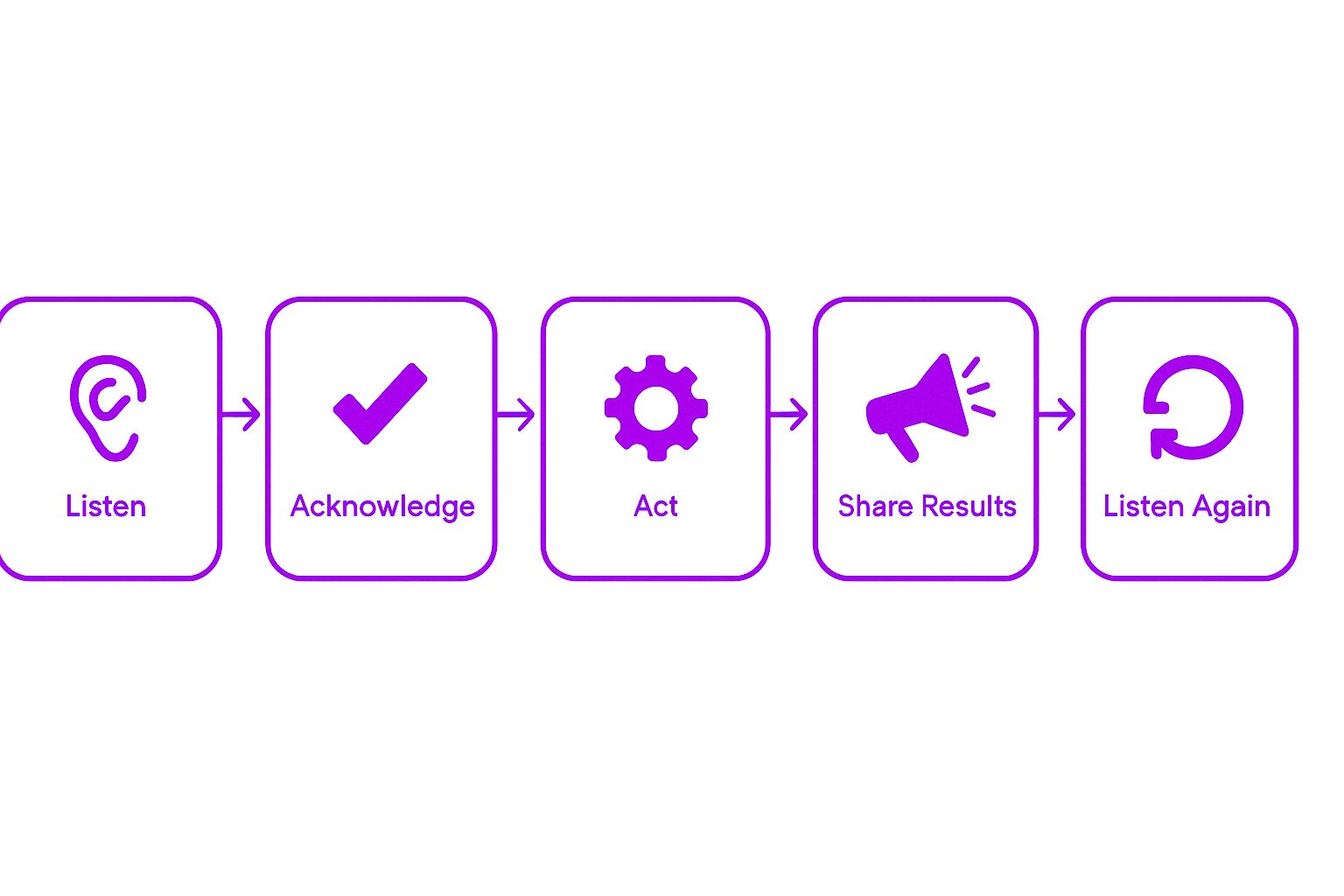What Is Employee Voice?
Employee voice is the ability of employees to share their thoughts, ideas, and concerns within a company. It refers to both formal and informal ways employees contribute feedback to management and influence decisions that impact their work. The concept of ‘voice in the workplace’ is critical for cultivating employee engagement and fostering a positive organizational culture. Employee voice plays a key role in building trust, engagement, and workplace satisfaction.
Companies that listen to employees create stronger, more committed teams. When employees feel heard, they are more likely to be engaged and invested in company success. When employee voice is ignored, frustration builds, morale drops, and turnover increases.
Why Employee Voice Matters
Organizations with strong employee voice strategies see benefits across the board. When employees feel empowered to speak up, companies experience:
-
Higher levels of engagement and productivity.
-
Improved problem-solving and decision-making.
-
Stronger trust between employees and leadership.
-
Reduced turnover and higher retention.
-
A more positive company culture with better teamwork.
Employee voice significantly impacts employee retention by making employees feel their input is valued, leading to higher job satisfaction and lower turnover rates.
Employees are on the front lines of daily operations. They see inefficiencies, challenges, and opportunities firsthand. Encouraging employee voice gives businesses insights that leadership might otherwise overlook.
Employee voice also enhances organizational performance by fostering a culture where employees feel empowered to share their opinions, leading to improved decision-making, operational efficiency, and overall performance.
Key Components of Employee Voice
Open Communication
Employees need platforms to share their thoughts, whether through direct conversations, surveys, or anonymous channels. Offering avenues for anonymous feedback is crucial for understanding employee sentiments, addressing concerns, and fostering a culture of transparency and engagement within organizations. Without open communication and honest feedback, employees may feel disconnected from decision-making.
Employee Involvement in Decision-Making
Companies that actively seek employee input during key discussions create a more engaged workforce. A formal employee voice, through mechanisms like structured employee surveys, plays a crucial role in ensuring that all opinions and feedback are systematically considered in decision-making. This could be through feedback meetings, strategy sessions, or project collaboration.
Recognition and Acknowledgment
Employee feedback should be valued. Organizations that take the time to acknowledge suggestions and implement changes based on employee input foster a culture of trust.
Diverse Employee Feedback Mechanisms
Not every employee is comfortable speaking up in meetings. An employee survey can be a structured method to gather and analyze feedback from employees, helping to understand their perceptions of the workplace environment. Businesses should provide multiple ways for employees to voice concerns, including town halls, anonymous suggestion boxes, and one-on-one check-ins. One-on-one meetings are also crucial as they create a safe space for employees to express their thoughts and opinions, fostering a culture of open communication and active listening from managers.
Action-Oriented Response
When employees share feedback, leadership must respond. If employees see that their input leads to real change, they are more likely to stay engaged and continue offering ideas.
Benefits of Encouraging Employee Voice
Higher Engagement and Productivity
Employees who feel their voices matter are more invested in their work. Encouraging open communication and feedback not only fosters employee voice but also significantly enhances employee satisfaction. They take ownership of their responsibilities and contribute more to company goals.
Better Decision-Making
Leaders who listen to employees gain insights from people who are closest to day-to-day operations. This helps in making more informed business decisions.
Stronger Organizational Culture
A culture of open communication fosters trust and respect. Employees feel valued and are more likely to collaborate effectively.
Reduced Turnover
Employees who feel heard are less likely to leave. When companies ignore employee feedback, workers seek opportunities elsewhere.
Improved Customer Experience
When employees feel empowered, they deliver better customer service. Engaged employees bring more energy and care into their work, directly impacting customer satisfaction.
Challenges in Implementing Employee Voice
Lack of Trust
If employees believe speaking up will lead to negative consequences, they will stay silent. Companies need to foster a culture where feedback is welcomed, not punished.
Poor Communication Channels
Organizations without structured ways to collect feedback struggle to hear employee concerns. A mix of formal (surveys, meetings) and informal (casual check-ins) methods ensures all voices are heard.
Leadership Resistance
Some managers may resist employee feedback, fearing it will undermine authority or create extra work. Leadership must be open to hearing—and acting on—employee input.
Lack of Follow-Through
When employees provide feedback but see no action, they disengage. Companies must communicate how they are using employee insights and follow up with visible improvements.
Cultural Barriers
In hierarchical workplaces, employees may hesitate to challenge leadership. Creating a safe space for feedback encourages participation at all levels.
Practical Steps to Strengthen Employee Voice
Provide Multiple Feedback Channels
Not every employee is comfortable speaking up in meetings. Employee voice examples can illustrate various initiatives that organizations can implement to enhance employee engagement and feedback channels. Offer various ways to collect feedback, such as:
-
Anonymous surveys
-
One-on-one manager check-ins
-
Open-door policies
-
Virtual suggestion boxes
Train Leaders to Listen
Managers should be trained to encourage feedback and respond constructively. Active listening techniques, non-defensive responses, and a commitment to action help build trust.
Acknowledge and Act on Feedback
Recognizing employee contributions encourages continued participation. Share updates on how feedback is being used and highlight employee-driven improvements.
Encourage a Safe Environment for Feedback
Employees should not fear retaliation for sharing concerns. Anonymous options and clear policies against retaliation create a safer environment for open discussions.
Foster Two-Way Communication
Employee voice is a conversation, not just an information-gathering tool. Encourage leadership to provide transparent updates on how employee feedback is shaping company decisions.
Employee Voice Mechanisms
Employee voice mechanisms are essential for creating a workplace culture that values and leverages employee voice. These mechanisms provide a platform for employees to express their opinions, ideas, and concerns, and for employers to listen and act on their feedback. By implementing effective employee voice mechanisms, organizations can ensure that every employee feels heard and valued, leading to a more engaged and productive workforce. These mechanisms are the backbone of a transparent and inclusive workplace culture, where open communication and mutual respect thrive.
Open-Door Policy
An open-door policy is a mechanism that allows employees to approach managers and leaders with their thoughts and concerns. This creates an environment of trust and accessibility, allowing employees to share their ideas and feedback directly with those who have the power to act upon them. An open-door policy fosters a culture of openness, collaboration, and innovation, encouraging employees to speak up and share their ideas, leading to better decision-making and outcomes. By encouraging employees to voice their opinions without fear of retribution, organizations can tap into a wealth of valuable insights and drive continuous improvement.
Related Concepts
Employee Engagement
Engagement is the emotional commitment employees feel toward their work. The voice of the employee, which encompasses the feedback and opinions that employees share about their work environment, plays a key role in engagement by making workers feel valued and heard. Employee voice plays a key role in engagement by making workers feel valued and heard.
Psychological Safety
A workplace where employees feel safe to speak up without fear of negative consequences. Psychological safety enables stronger employee voice.
Workplace Democracy
A management approach that actively involves employees in decision-making processes. This strengthens employee voice by giving workers real influence over company direction.
Organizational Transparency
When companies share information openly, employees feel more connected to decision-making. Transparent communication enhances employee trust and willingness to share ideas.
Real-World Examples
Google’s Open Q&A Sessions
Google encourages employee voice through weekly Q&A sessions where employees can ask executives any question. This transparency fosters trust and collaboration.
Microsoft’s AI-Driven Employee Surveys
Microsoft uses AI-powered feedback tools to gather real-time employee input. This allows the company to adapt policies and improve work environments based on real concerns.
A Retail Chain’s Employee-Led Initiatives
A large retail company implemented an employee-driven feedback system that led to significant operational improvements, from scheduling adjustments to customer service enhancements.
A Healthcare Provider’s Leadership Rounds
A hospital system implemented “leadership rounding,” where executives regularly meet with frontline employees to gather input. This led to process improvements and higher job satisfaction among staff.
Final Thoughts
Employee voice is not just about giving employees a platform to speak—it’s about actively listening, acting on feedback, and creating a culture where every employee feels valued. In the field of human resource management, fostering employee voice is crucial for open communication and encouraging employee participation in decision-making. Organizations that prioritize employee voice build stronger teams, improve decision-making, and retain top talent. Encouraging employees to speak up is one of the most effective ways to foster engagement and long-term business success.







